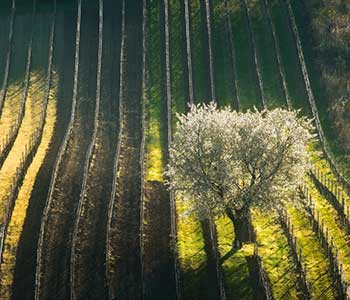
Vitiforestry. Agroforestry for the viticulture.
The term "vitiforestry" is becoming increasingly important. It is therefore time to take a closer look at it. Vitiforestry is the adaptation of the concept of "agroforestry" for viticulture. However, combined agriculture and forestry is not a modern invention. Already our grandparents and their ancestors planted trees in the fields on their mixed farms. But from the middle of the last century, this was no longer the case in many areas. Land consolidation and monocultures became state of the art - with all their negative effects on nature. Only in biodynamics were biodiversity areas with trees and hedges laid down in the guidelines and remained in place. What is new, however, is the programmatic approach based on scientific findings and empiricism.
March 2023
Which trees are suitable for viticulture can be found on the Delinat website (German language)
More information on vitiforestry can also be found at → Delinat
- With Trees against Drought. Hübner, Rico. German Association for Agroforestry, 2023
All cited information in German language
Agroforesty combines elements of agriculture and forestry. Trees or hedges and shrubs are grown and used on the same land as agricultural products. Often animals are also kept there. The positive interactions are manifold and bring social, economic and ecological benefits to land users at all levels. In regions where coffee or cocoa is grown, for example, agroforestry reduces deforestation and water mismanagement. The World Agroforestry Center, founded in 1978, aims to contribute to poverty reduction and food security through ecologically adapted production methods. In the wake of climate change and soil degradation, more and more farmers in Western countries are making a choice in favour of agroforestry. This method is also finding more and more followers among winegrowers.
The renowned Champagne house Ruinart is currently causing a furore by integrating trees and shrubs into its vineyards in order to promote biodiversity and make the cultivated areas more resistant to the effects of climate change. This is also making itself felt in Champagne, where grapes have been ripening far too early for several years and sugar and alcohol levels are too high. The harvest in this region, once known for its cool climate, often begins in August instead of at the end of September as it used to. Since 2021, Ruinart has planted around 14,000 native trees and shrubs such as hornbeam, lime, dogwood and hawthorn on its 40 hectares of vineyards. By 2023, this number is to be as high as 20,000, as the German wine portal wein.plus reports.
The Gut Hardegg in the Weinviertel is considered a model farm in Austria for biodiversity measures in vineyards and fields. On 9 % of its total area of 2,200 hectares, it dedicates itself to planting trees, flowering strips, beetle banks and renaturation zones. And Fritz Wieninger from Vienna also emphasises the importance of biodiversity for his vineyards and has planted another 120 fruit trees of different varieties there in recent years in addition to the existing trees - including apricots, plums, sour cherries, peaches, quinces, walnuts and hazelnuts, as well as some oaks. These are to attract insects and provide them with food, give birds and squirrels a home. At the same time, the fruits are to be harvested and processed. An agroforestry model par excellence!
BENEFITS of agroforestry. Trees, hedges and shrubs on and around agricultural land have a positive effect in many ways:
- soil health and humus build-up (soil loosening, water storage capacity, ...)
- soil life (microorganisms, mycorrhiza, funghi, earhworms, …)so that more biodiversity is also available above
- habitats for animals, birds, insects
- more diverse and more yeasts on the vines
- water retention capacity. Anything that creates structures keeps water in the soil through less wind, less evaporation and erosion control. For this reason, it is also advisable to terrace vineyards.
- regulate groundwater levels and reduce nitrate content
- Climate change adaptation (evaporative cooling and shade)
- shade maintains photosynthesis (which stops in the vines at 38° Celsius)
- wind creates turbulence through trees or shrubs, has a positive effect on temperature and humidity (beware, in winter hedges can scatter cold and lead to frost. Positioning must be well planned).
- CO2 storage (However, the storage capacity depends on the soil. If the soil is already saturated, no more CO2 is absorbed. According to expert Hübner, this applies to meadow orchards, for example.).
- wind and erosion protection
- less need for plant protection products and fertilisers (= CO2 reduction)
- vines are less susceptible to diseases and pests
- cultural asset
- economic benefits from wood and fruit
Here's to good neighbourliness! According to agronomist Rico Hübner, competition with regard to water and nutrients as well as a slight reduction in yield only occur in the immediate vicinity of trees and shrubs. Since trees root in different soil zones than vines or crops, competition is likely to be rather limited in his opinion. In zones with greater distances, there may even be an increase in yield.
Depending on the location, orientation, nature and size of the vineyards, trees, hedges and shrubs can be planted either in the middle of the vineyard, at the edge or even specifically as their own rows (alley cropping). However, it should be noted that machines have to pass between the vine rows and turn around at the end. So when planting trees in this area, it is essential to consider their size growth. Advice is needed to avoid making mistakes. Mistakes that may not be discovered until years later and can result in serious costs as well as a negative impact on the environment.
Not all trees are the same! Not every tree is a suitable partner in the vineyard. It is important that a tree is site-appropriate, native and able to withstand the challenges of climate change. Oaks would be a good choice for the latter, but they are too strong competitors for vines within a radius of 10 to 15 metres. If there are already oaks in the vineyard, one can mitigate this effect by planting rose pears or wild plums between them and the vines, as the French consultant Erik Bergmann explained in his lecture at the Demeter Days 2023 in Vienna. In his experience, ash trees, all fruit trees, rowan, woodpecker, wild pear, almond and mulberry are always good partners for vines. In southern regions, fig and olive trees are traditionally good neighbours for vines.
It is well known that forests near vineyards have a cooling and balancing effect. A new insight for some, however, is that preference should be given to deciduous trees when reforesting. This is because conifers also evaporate in winter and extract moisture from the soil.
Good things take time! The first effects of newly planted trees and shrubs are noticeable after about three years and become more noticeable after five to ten years. As the plants increase in size, the positive effects manifest themselves faster and stronger. It is also advisable to adjust the age of the trees and shrubs to that of the vines. Some fruit trees reach this after 20 years and have to be felled. This is work that usually requires the use of heavy machinery.
When tree or shrub zones are cleared, the healthy soil can be used for crops or even new vine plantations. Time for new partnerships!
Supplement 2024/04. Further Vitiforestry protagonists: Alwin Jurtschitsch and Franz. R. Weninger.




